"In science, "fact" can only mean "confirmed to such a degree that it would be perverse to withhold provisional assent." I suppose that apples might start to rise tomorrow, but the possibility does not merit equal time in physics classrooms." -Stephen Jay Gould
Those of you who follow me on either google+, facebook or twitter know that I sometimes post interesting articles about science from around the world, including this very good article about myths about outer space, from the often-entertaining cracked.com. So, as you can imagine, I was (at first) very excited when I saw this article last week over there.
Imagine my disappointment when I read this, and realized that the "6 Scientific Discoveries that Laugh in the Face of Physics" turn out to all be things that physics understands and can explain! Looking at it today, you can see that well over 1,000,000 people have read this, so let's see if we can't get the correct information back out there to as many of them as possible. Without further ado, let's take a look at these six scientific discoveries, and do our best to get it right!
[caption id="attachment_18180" align="aligncenter" width="600" caption="Image credit: Miloslav Druckmuller / SWNS."]
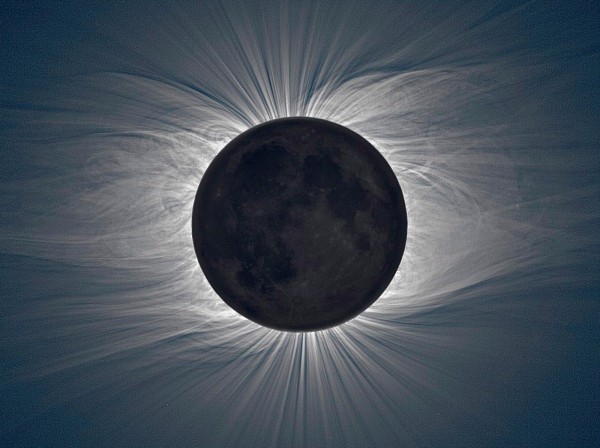 [/caption]
[/caption]
6.) The Sun Can Make Stuff Hotter Than Itself.
Above is the Sun's Corona, visible only during a total solar eclipse, as shown above. And while the surface of the Sun is very hot, at something around 5800 K, the Corona comes in at temperatures over one million Kelvin. Mysterious, mind-boggling and inexplicable by the laws of physics, right?
Except that temperature is not the same thing as heat! The Sun's surface is much, much denser than the incredibly rarified corona, so that even though the Sun's photosphere is less than 1% of the corona's temperature, it emits energy at a rate that's over 40,000 times the amount required to heat the corona up to it's high temperature. We even think we know why: the wave heating theory, where energy can be transferred over long distances from the solar interior to the corona.
Remember what temperature is: a measure of the mean speed of the particles. Similar to how two balls -- a tiny one and a very massive one -- dropped one-atop-the-other will lead the tiny ball to rocket upwards at an incredible speed, the problem isn't getting a few particles to have a very large speed. The problem also isn't unique to the Sun; if we take a look at Earth's upper atmosphere, where it gets really rarified (above 80 km), we find that it does the same thing in terms of temperature!
The problem is that we associate temperature with heat in our minds, but the "very high temperature" corona contains almost no heat! But if we look in terms of heat, the Sun's photosphere contains much more than the corona; the corona merely reaches higher temperatures.
[caption id="attachment_18183" align="aligncenter" width="600" caption="Image credit: © 1968 George Resch - Fundamental Photographs."]
 [/caption]
[/caption]
5.) When You Look Closely, Gravity Stops Making Sense.
The article laments that gravity is so mind-numbingly weak. How dare you, gravity! And it's true; weaker by something like 38 orders of magnitude than the electromagnetic force, even your puny comb can outdo the gravitational pull of the entire Earth when it comes to lifting certain objects. But this isn't a mystery, it's an empirical fact of nature!
The standard model of particles and interactions can do a whole lot, but one of the things it can't do is explain why the fundamental forces are the strength that they are. Neither can general relativity, our theory of gravity. As you can see, gravity is very, mind-numbingly weak, even compared to the weakest other force.
But whether you look close or far, at something as massive as a supermassive black hole or as tiny as a laboratory mass, general relativity still gives the correct answer to everything. The only argument that one could even make that "when you look very close, it stops making sense" would be to go down to the smallest scales we know of.
Only, with gravity, we can barely make it below the millimeter-scale before it becomes too difficult to measure. And we can measure the effects of gravitation down to these sub-millimeter scales: it obeys general relativity just fine, thank you. Perhaps someday, we'll reach down to quantum mechanical scales and find that our classical theory of gravity, general relativity, is insufficient. But in theory, general relativity is good all the way down to the quantum limit of the Universe, and we have yet to find an experiment or observation that contradicts it.
[caption id="attachment_18186" align="aligncenter" width="600" caption="Image credit: Pioneer 10 by Don Davis, for NASA."]
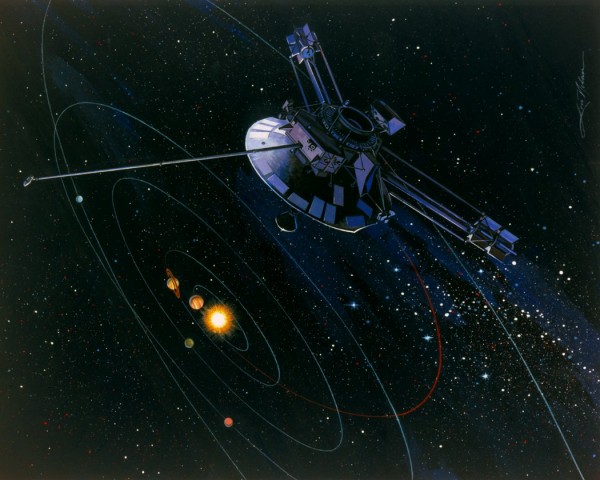 [/caption]
[/caption]
4.) Satellites Speed Up for No Reason.
So, get this. In the 1970s, we launched two probes -- Pioneer 10 and 11 -- into the outer Solar System. As we tracked their positions over many decades, we knew exactly what to expect. After all, we know the laws of gravity, we know the masses and positions of the Sun and all the planets, and we should be able to predict the spacecrafts' motions flawlessly. Except we saw a small -- but definitely non-negligible -- acceleration back towards the Sun!
Immediately, a number of spectacular explanations arose. Gravity is wrong! The solar system is full of dark matter! Spaghetti! Except among most astrophysicists (like me), another explanation arose: maybe the asymmetric spacecraft is being heated (and is radiating) asymmetrically.
For decades, the debate raged, as much as anything where one side doesn't really give the other side much credibility can rage. And then last year, it was definitively measured that the "anomalous acceleration" is not constant, but decreasing, and hence in total agreement with the theory that it's due to the thermal effects that the astrophysicists pointed out. So yes, cracked, satellites speed up for no reason, but only if you ignore the actual reason.
[caption id="attachment_18188" align="aligncenter" width="580" caption="Image credit: retrieved from Phantastic Physics / Wikispaces."]
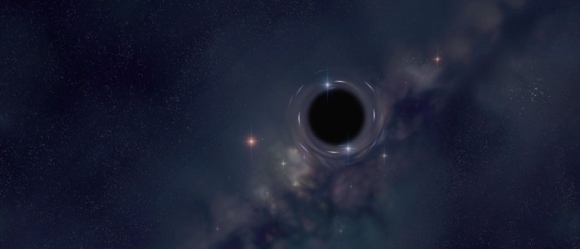 [/caption]
[/caption]
3.) The Law of Conservation of Energy? More of a Suggestion, Really.
Looking at black holes, there are only a few types of hair they can have: mass, angular momentum, and electric charge. (And, if you believe in it, magnetic charge.) All of that stuff is conserved. But what about information? That's something that needs to be conserved. If I throw the Count of Monte Cristo into a black hole, it contains a different amount of information than an equal-mass book of all work and no play makes Jack a dull boy. But if energy must truly be conserved, mass, charge, and angular momentum won't take care of it! This conundrum was known as the black hole information paradox.
I said "was known" as that. Because the information isn't lost; we know exactly where it goes! When any object falls into a black hole, from its point of view, it simply passes through the event horizon and falls into the singularity, getting torn apart in spectacular fashion. But to an observer outside the event horizon? The object appears to get stretched out, fainter, and reddened, but you'll never see it cross over onto the inside. What we see, instead, is that information gets imprinted, forever and ever, onto the surface of that black hole's event horizon!
So even though you might have amazing difficulty reading it, that information from the Count of Monte Cristo is still there on the surface, even if its mass is the only thing you know from the black hole's insides.
[caption id="attachment_18190" align="aligncenter" width="490" caption="Image credit: Indira Gandhi Center for Atomic Research."]
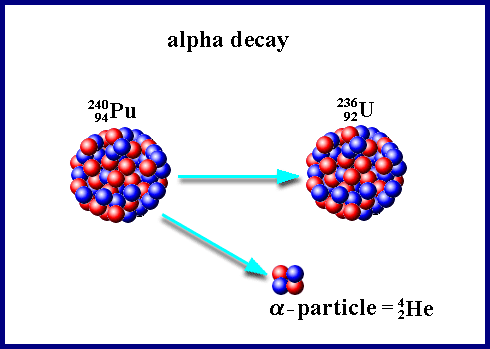 [/caption]
[/caption]
2.) The Particle That Knows We're Watching.
Radioactive decay, the process that allows an unstable atomic nucleus to transmute into a different element, is one of the slowest physical processes known to man. Often taking billions of years, radioactivity is built on a foundation of quantum mechanics, where a metastable nucleus must quantum mechanically tunnel into a less energetic, more stable state.
It isn't easy, as you can imagine, because there's no good way to get up-and-over the proverbial hill; it isn't like those protons and neutrons just spontaneously align into that less energetic configuration! What you need to remember is that each of these particles that make up the nucleus are quantum mechanical in nature: they're not just particles, but they're waves, too. And waves spread out over time, where they can attempt to tunnel into that more stable (post-decay) state. Every once in a while, after enough time has passed, a nucleus will find its way into that state, and when that happens, you get a decay!
But it takes time to get there. If you're too impatient, and you can't wait, you might be tempted to look right away. Only, you know what happens in quantum mechanics when you make an observation: you collapse the wavefunction into one particular state! So if you can't help yourself from making observations, what you're basically doing is resetting the clock every time you look!
If you're cracked, you'll lament that this is like the watched teapot that never boils. While if you're a physicist, you know the teapot boils, but the nucleus won't decay unless you stop continually collapsing its wavefunction!
[caption id="attachment_18194" align="aligncenter" width="550" caption="Image credit: CERN neutrinos to Gran Sasso, retrieved from Universe Today."]
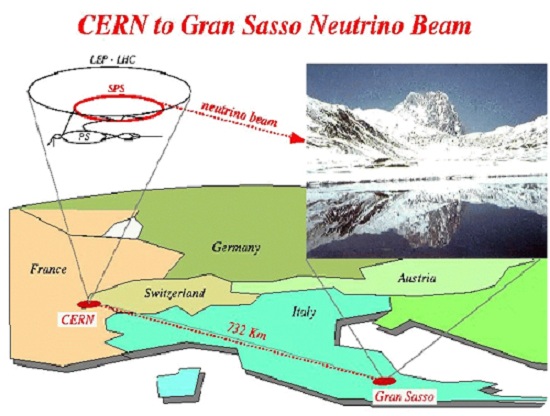 [/caption]
[/caption]
1.) Einstein's Theory: Relatively Full of Crap (Also? Time Travel!).
And finally, the faster-than-light neutrinos thing, again. For those of you who've been living under a rock, the OPERA experiment in a mine under Gran Sasso detected neutrinos sent from CERN, and they detected them 60 nanoseconds sooner than they would have had they moved "only" at the speed of light.
Like many others, I was skeptical, and believed we were fooling ourselves. I still am, and I still do. We have plenty of evidence indicating otherwise.
For one, we had a supernova in 1987, which raced photons and neutrinos for over 100,000 light years; were the neutrinos moving at the speed OPERA indicated, they'd have arrived four years earlier; instead, they arrived within hours. There are actually a host of other experiments that have constrained the speed of neutrinos, and if you look at all of them -- across a wide variety of energies -- you find that the new experiment, OPERA, is the one outlier, in conflict with everything else.
The OPERA results are bizarre enough that experiments in the United States and Japan are being set up right now to either verify or refute them. When it comes to this story, I've been doing my best to inform the world, and I'll stay on top of it and keep reporting all the latest developments that come up, too. But for right now, it's going to take some extraordinary evidence before I'm ready to chuck special relativity, even for something as mundane as the neutrino.
And there you have it: six scientific discoveries that might appear to laugh in the face of physics, but only until you learn the physics behind it! Isn't information beautiful?

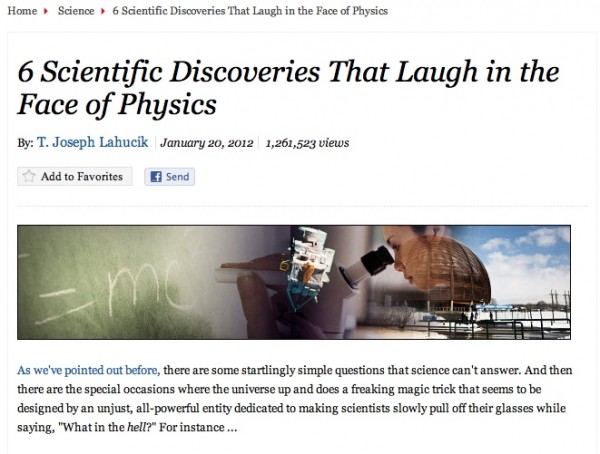
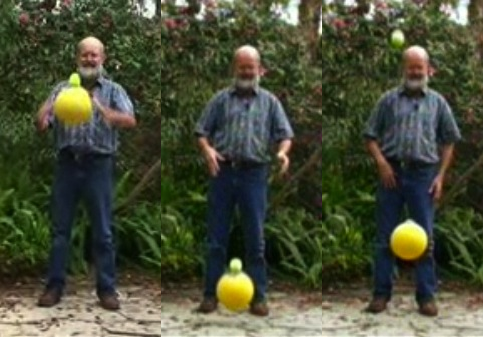
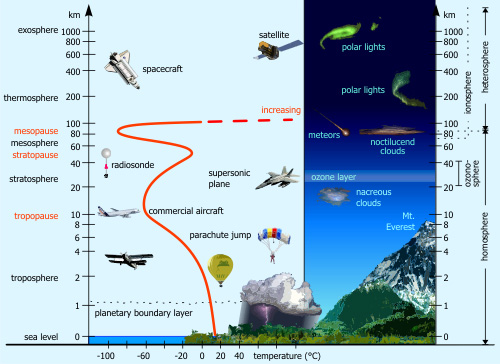



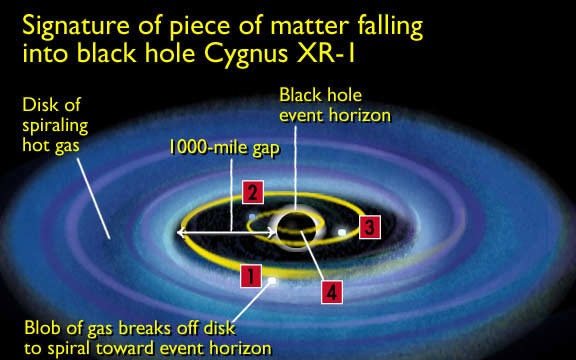
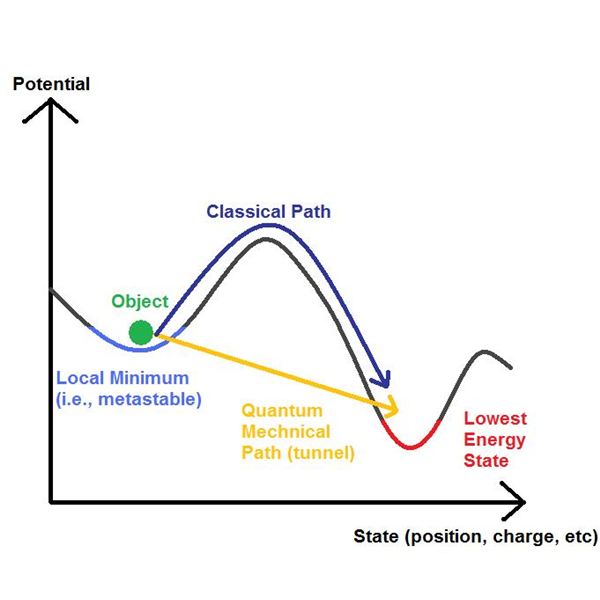

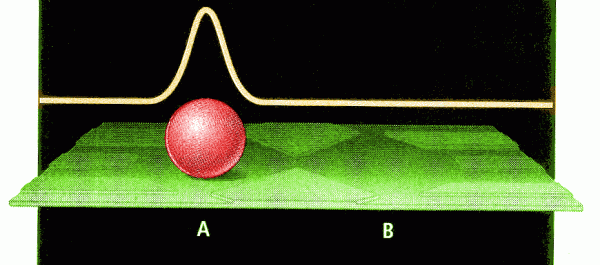
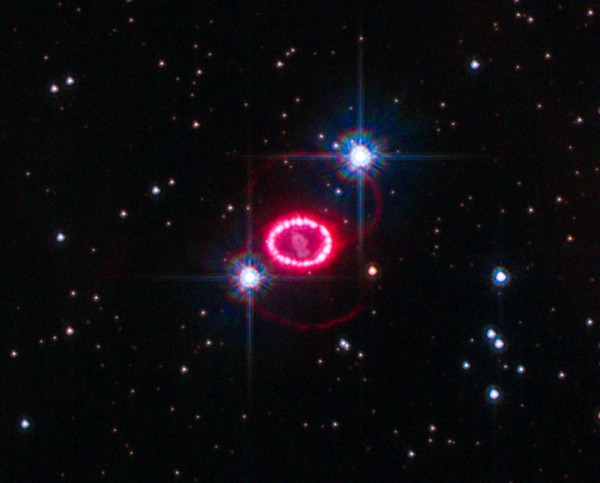
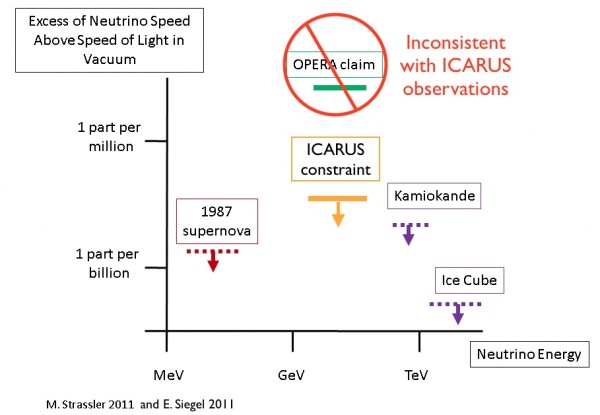
"But for right now, it's going to take some extraordinary evidence before I'm ready to chuck special relativity, even for something as mundane as the neutrino."
Mundane as the neutrino, huh? Keep telling yourself that you quack.
Thank you! When I read the Cracked article my first instinct was to come back here and try to search and collect articles explaining those "baffling mysteries" away, but now there's a single article to refer. On to the comments section!
Congratulations on your usual clearly written and reliable explanation. Thanks.
"For one, we had a supernova in 1987, which raced photons and neutrinos for over 100,000 light years; were the neutrinos moving at the speed OPERA indicated, they'd have arrived four years earlier"
Really? So ALL neutrinos go FTL? Is that what the CERN experiment is saying?
Or are you strawmanning here, Ethan?
Now, if not all go FTL, then please answer me: were we looking for a neutrino burst from a supernova in 1983?
No, we weren't.
Nicely done! I was pretty pissed at Cracked too when I saw this article. Well, you know, they're a comedy site so I guess we shouldn't expect them to be fully informed about these cutting edge science topics (some of these explanations are actually quite new, I remember reading about the unresolved state of the Pioneer anomaly back in 2005). But then again, this is still misinformation.
Anyway, I have a question. In number 2, you are obviously referring to the quantum Zeno effect, which I find absolutely fascinating. Do you know if this has ever been observed experimentally? Could we potentially learn more about what actually counts as a quantum mechanical measurement finding out what causes this effect and what doesn't?
We have something called "the Lamb shift" which shows that, even if not *real* real, has real effect as though it were.
http://en.wikipedia.org/wiki/Lamb_shift
Even if not entirely what you were asking, Michael, it's in the sort of direction I believe.
@Wow #4: That's an extraordinary bit of special pleading, there. You're suggesting
(by implication, rather than standing up and saying so clearly), that only the particular neutrinos in the energy range of CNGS happen to be superluminal. That all other neutrinos, both lower and higher in energy, are not. Oh, and you also seem to be implying that only the neutrinos that got detected by OPERA were superluminal -- the other ones from CNGS, which ICARUS detected, weren't superluminal either (see below on Cohen-Glashow radiation).
As you know, Kamiokande-II was not "looking for a neutrino burst from a supernova" in 1987 when it seredipitously observed SN 1987a. It was looking at solar neutrinos in an attempt to solve the then-confusing "solar neutrino problem."
In 1983, there were two neutrino observatories running, the original KamiokaNDE (yes, that's how it was written) and Baksan. So in principle, either of them could have serendipitously seen a burst of superluminal neutrinos from SN 1987a.
Of course, as Cohen and Glashow have pointed out (using entirely well-tested physics of weak interactions), those hypothetical superluminal neutrinos would have radiated away their energy during the 160,000 light-year trip from the LMC.
So in fact, no one would have seen a burst of surperluminal neutrinos, and no one would have seen the non-superluminal events in Kamiokande-II either. But since we did see the latter, we can draw a simple conclusion.
"Except that temperature is not the same thing as heat!"
Additionally, temperature doesn't make a lot of sense when it's rarified. What's the temperature of an atom? You need lots to do that. But then over a light year of space, you can GET lots of atoms. But they don't interact with each other much if it's rarified, though the NUMBERS can be big enough to compare to a glass full of atmosphere from the surface of the earth, where you CAN call it "temperature".
There are plenty of ways in which "OMG! The Corona is millions of degrees hotter than the sun" isn't really a killer blow to physics.
You're suggesting (by implication, rather than standing up and saying so clearly)
I thought it was pretty clear. But if you insist: I'm saying it: only some neutrinos are superluminal.
Happy?
Also note that these were very light forms of neutrino. Extrapolation of macro-scale (and compared to the keV of an electron which ALREADY has problems with such things as "spin" that acts like spin, but can't 'cos the edge would be going faster than light), the eV that the neutrinos they consider to be going FTL is a pretty large extrapolation.
Add that the energies are very high again compared to what we manage to get with larger objects.
But the "the 1987 supernova shows they're wrong" is rather crappy an argument for the questions I asked. Additional problems are that, since the speed of neutrinos should be LESS than lightspeed because they're massive, should we not have seen them in 1991? Shouldn't they have spread out with mass as well as energy?
I suspect something *other* than superluminal travel going on, but this is a "huh, that's weird" moment. And that pish-tosh rebuttal was not even worth the thought of an infant.
@Jon Jones
While I do disagree with the comment "even for something as mundane as the neutrino." ... neutrinos are a piece of the standard model, and maybe not as exciting as exotic particles. They still important to look at them, and see if they conform to all standard model/relativity predictions.
On the other hand, how is the poster a quack? His main thesis makes complete sense ... Just because the OPERA results are weird, doesn't mean it is time to throw out relativity just yet. One still needs confirmation from other neutrino experiments.
Unexpected results come out of HEP all the time, only to fade away with more data, or not be confirmed by other experiments.
"So in principle, either of them could have serendipitously seen a burst of superluminal neutrinos from SN 1987a."
And since there was nothing to explain the cause, removed as a random non-neutrino event.
"Just because the OPERA results are weird, doesn't mean it is time to throw out relativity just yet."
When General Relativity proved the better, we didn't throw out Newtonian Gravity. We just realised it wasn't as complete an explanation and found one that explained even more.
No doubt science is good at explaining things, but one still might object to the idea that science already explains everything, as Sean Carroll laughably asserted in Discover magazine a while back. So, #6: OK, it isn't a massive violation of thermodynamics, but "we even think we know why", followed by a plausible but somewhat handwavy explanation. I take it that the implication is that "we" can't actually do the math (not that I could even if somebody can). #5, "one of the things [the standard model] can't do is explain why the fundamental forces are the strength that they are". And so it goes.
So it's a true point that (even aside from problems like three-bodies where we understand what is happening but can't compute an exact solution) a scientist can expect to be confronted with "WTF???" moments. In fact, my understanding is that scientists LIVE for those moments when the null hypothesis is invalidated. And there's still plenty of mystery at the bottom of the barrel.
True enough, Newtonian gravity is not thrown out ... god knows I've used it many times myself in calculations when appropriate.
At the same time, I think it is to early to say that the OPERA result actually demonstrates chinks in relativity.
Additionally, temperature doesn't make a lot of sense when it's rarified.
True, most of our everyday intuitions about temperature break down, but that doesn't mean that temperature isn't a useful concept. It means you have to worry about higher order moments, which if you had a Gaussian distribution of velocities (for historical reasons this is known in plasma physics as a Maxwellian distribution) would be identically zero. The reason you get non-Maxwellian distributions is, as you say, because particle collisions are infrequent enough to be negligible, and many particle acceleration processes in plasma astrophysics tend to produce power law distributions. But fluid descriptions of plasmas, such as magnetohydrodynamics, still work in this regime, or at least are good enough approximations to describe many phenomena of interest. You have to make some assumption about a certain higher order moment in order to close the set of equations, but most of the time you can make an assumption that is close enough to reality.
I feel the need to offend and insult the author of this blog because I read this page religiously and am constantly bombarded with some of the most over dramatic, dogmatic, short sighted garbage that I have ever read. The persistent dismissal of anything that contradicts the commonly accepted view of the universe is almost ironic. I feel like the pope himself will administer a gay marriage ceremony before anyone in the scientific community will accept a model of the universe that does NOT include dark matter, or allows for exceptions or rejections of relativity. At what point does the community of physicists as a whole begin to reflect the same ignorance and intolerance of new ideas that the Catholic church showed to them in the early renaissance?
@Jon Jones
What specifically about the blog post do you not agree with? Do you disagree with the refutations, or the clarifications, of the physics behind the cracked.com article?
The current physics theories explain a lot of observed phenomena ... the standard model agrees very well with the cross sections I measure in my analysis. That does not mean there isn't a more encompassing theory where the current theories are a special case or approximation.
Claims of turning the world of physics on its head need extraordinary evidence. Hints (such as the OPERA experiment) are nice, and interesting, but not enough.
That's the problem, Stewart, if you compromise your intellectual integrity by studying the physics then you will have been indoctrinated into toeing the same line Ethan has to.
Original thinkers like Jon, however, whose minds are unsullied by study, can invent perpetual motion machines thanks to the genius of ignorance.
@ Vince
Who says I'm not studying?
No doubt science is good at explaining things, but one still might object to the idea that science already explains everything, as Sean Carroll laughably asserted (Discover magazine blog for 2010/09/29 ... maybe we can't put links in comments here???) a while back. So, #6: OK, it isn't a massive violation of thermodynamics, but "we even think we know why", followed by a plausible but somewhat handwavy explanation. I take the implication to be that "we" can't actually do the math (not that I could even if somebody can). #5, "one of the things [the standard model] can't do is explain why the fundamental forces are the strength that they are". And so it goes.
So it's a true point that (even aside from problems like three-bodies where we understand what is happening but can't compute an exact solution) a scientist can expect to be confronted with "WTF???" moments. In fact, my understanding is that scientists LIVE for those moments when the null hypothesis is invalidated. And there's still plenty of mystery at the bottom of the barrel and I suppose there always will be.
Happy to report a number of my 6th graders could tell you heat and temperature are not the same thing. I guess teaching the layers of the atmosphere was good for something. :-D
Jon Jones, I think the problem that you're having is that everyone is ignoring one very fundamental fact. Namely, you're a fucking loon.
Thanks ethan! I posted a comment on the article at the time pointing out the innacuracies, but you've explained the issues much better and in more detail. Well done!
Ah, the Pioneer Anomaly. Such a glorious litmus test for looniness. Crackpots just can't resist pointing at Pioneer and saying "See?! This proves modern physics is a bunch of hokum, and the Scientific Clergy just won't admit their Dogma is wrong! But if they had an ounce of brains, they'd see that [my pet theory published on my blog] is obviously true!"
Which just instantly shows you the kind of scientific integrity they (don't) have. They aren't aware of the various proposed solutions, the implications that have and have not been considered, and ultimately the volumes of evidence for the current theory that would make it foolish to take one unexplained happening and say you have to throw everything out. Especially because, like in so many, many cases, ultimately the solution involves not upending all of known physics, but rather better understanding the specifics of the scenario at hand.
Of course none of these revolutionary thinkers ever came up with the idea that maybe the problem with Pioneer was that it couldn't be modeled as a sphere of uniform density. Cus where's the fun in that?
On a completely unrelated topic: Jon Jones, if you'd done the studying you are implying you have, then you'd have come across all the theories the scientific community has come up with as alternatives to DM or GR that are accepted in direct proportion to the relative evidence for them. You'd know that there are scads of scientists trying like heck to explain the universe without the need for DM -- but that they can't yet do as good a job as the explanation that does include it! As soon as that's not the case anymore, you'll start to see DM fall by the wayside and the new theory take over.
And then some time later, someone like you will come by and say "I feel like the pope himself will administer a gay marriage ceremony before anyone in the scientific community will accept a model of the universe that does NOT include [the new theory]". Almost as though they are completely oblivious to how the theory came to be accepted.
I often visit Cracked.com during "slow" days at the office, but many of their science articles are incorrect or misleading....but their hipster articles are great!
Whatever. Call me names, and personally attack me because your facts break down.
Prove to me the OPERA results were flawed.
Prove to me the existence of Dark Matter, beyond implied data.
Prove that neutrinos are irrelevant even if that are faster than light.
I don't think it is fair to say that the faster-than-light-neutrino result is "in conflict with everything else". For one thing, the MINOS/Fermilab result http://arxiv.org/abs/0706.0437 from 2007 also pointed towards faster-than-light neutrinos (though not as significant as OPERA, but combining two independent results obviously raises the significance.) And then there are the repeated measurements of imaginary neutrino mass, as summarized in http://arxiv.org/abs/0909.2104
Ethan, it shows that you are a believer out to defend science against perceived attacks, and so you slide into naive scientism. No, temperature is not just the velocity of particles, and you know that! Temperature is about equilibrium, and that one of two reservoirs in contact is a million times denser and has more heat as an explanation for a temperature difference is something no undergrad should get away with. How on earth do you let yourself down to such a level? Just a knee jerk reflex to "defend" holy physics? That is not acceptable for a science blog! Then you go on with the pioneer anomaly, which is not all of a sudden fully resolved just because there are two pre-prints that claim to see more of the effect you like to see. Did you even read those papers - did you perhaps not notice how preliminary their conclusions are? And black hole information conservation is proven? That is certainly news to me. Since when, Ethan? Because string theory has black D-branes? Science is about empirical data also in those cases where it does not yet support your pet theories! I have no mood to get into the other mistakes here - except that people, me included, told you several times why the supernova data and OPERA are not necessarily contradictory - no idea why you just keep going with the same lame argument again and again and again. What is it that drove your argumentations here - craving the support of certain people? This is not how you convince doubters, this is how you make sure that those who distrust scientism are confirmed in their fears. Please do not join the many pseudo-skeptics just for the easy clicks and invitations to fashionable circles. You do not need to!
@Jon Jones
No one is naming calling or being insulting but you.
1) It is not about proving the OPERA results right or wrong. HEP experiments are complex and rely on precise knowledge of your detector ... so there are many things that can lead to errors. You may have noticed that most modern collider experiments have 2 general purpose detectors to double check results (eg. H1 and ZEUS, D0 and CDF, ATLAS and CMS). The OPERA results would imply something very different is going on, something not allowed in relativity ... that is a BIG thing if true. Hence it needs conformation from other experiments. If they found the same result then "YAY" something really neat has been found. If not, it might be time for the OPERA collaboration to go back and sort out what was wrong.
2) What exactly do you mean by "implied results"? Do you mean from implied data ie) galactic rotation? or from knowledge about dark matter that isn't from data?
Look, assuming our theory of gravity is correct, postulating that some sort of weakly interacting dark matter makes sense. It is not something wild to postulate. Therefore scientists are going to concentrate on looking for candidate particles or work on theory related to this.
But it could be something else, maybe some sort of modified gravity ... and there are people who are studying this.
I'm not sure what you want? Do you have your own theory that you would like every scientist to agree is correct?
3) They aren't irrelevant in my opinion ... if they go faster than light then that is weird and unexpected ... especially since it only appears to happen under very specific conditions.
Why are you so angry?
The beauty of cracked is that no matter how complex the theory at hand, they explain it with the average Joe in mind, I tried to finish this article but it seams to be written for people with at least a degree in physics, Cracked has had over 1000,000 reader because you can bet almost all of the understood the article if this article really intends to educate the masses then at least give the a fighting chance to understand it.
Regarding the OPERA results: Note the figure in the original post where Ethan shows upper bounds on v - c for various neutron experiments. Assuming that's a log scale on the Y axis, OPERA comes in three orders of magnitude higher than the ICARUS experiment in the same energy range. That doesn't prove that OPERA is wrong, but it does prove that OPERA and ICARUS cannot both be correct. Since OPERA is also an outlier compared to what has been measured in other energy ranges, Occam's razor tells me that there is probably some not-yet-identified systematic error in the OPERA results.
Coronal heating is an active research area; I know several people who are working on the problem. There are several proposed mechanisms, all of which operate via classical E&M. We haven't determined which one (or several) is the correct mechanism, but that doesn't mean we can't explain the process.
As I have said before, dark matter is one of only two allowed classes of theory (alternative theories of gravity are the other) that can be invoked to explain galaxy clusters. Dark matter theories have at most two free parameters (average density and effective temperature), and having set those two free parameters to best fit the distribution of galaxies in the universe, we can explain a lot of other phenomena as well. Alternative theories of gravity do not accomplish this, at least for a uniform choice of the free parameters in those models.
Lol U Mad Bro?
I know better than to consider myself an amateur physicist. My knowledge is filled with holes. But, I can safely say that you probably shouldn't call yourself a physicist either. Or at least, not one that should be doing anything outside of research.
You see, I decided, on a whim, to check out some of Cracked's sources. And, interestingly enough, they are closer to correct than you are. Not to say that you are wrong... Simply that you have created strawmen. Especially in regard to number 5. You talk about so many of these problems as if they've been solved, when they simply have not. I'm sure the physicists devoting their time to solving this problem would not take kindly to you dismissing it as solved.
Maybe since we don't know the Higgs mass, we should just disregard all potential problems that come about from knowing it.
Yes, that sounds excellent.
"Assuming that's a log scale on the Y axis, OPERA comes in three orders of magnitude higher than the ICARUS experiment in the same energy range."
And still an error of, what was it? 0.000063%?
Now, compare the visible mass of the universe to the mass of the visible part of the universe. There's an order of magnitude difference (near enough) there.
Or Dark Energy vs the vacuum energy. What was it? 120 orders of magnitude difference there?
Were these told they were hogwash, or was a way found to keep the standard theories working with the visible data undertaken?
They did a reworking to remove the valid criticism of error bars including the "no, it's not going FTL".
So it remains.
Rather than whine "it's just plain wrong", have a look yourself and see where they got it wrong. Or how what they saw doesn't mean what they think it does. Or just test your theory again to make sure you ARE right.
"Prove to me the OPERA results were flawed."
This is not science.
Science would be wondering "How could it be right?" and for the members of the team "How could we be misinterpreting this?".
Ask questions of yourself before you demand of others.
"but one still might object to the idea that science already explains everything"
Rather like the denialist meme of "The science is solved", nobody says that science already explains everything.
Unless you're in junior school in the science class. And that for very obvious and accepted reasons.
"At the same time, I think it is to early to say that the OPERA result actually demonstrates chinks in relativity."
But it does hint at it.
Hence the quote from Ethan on my frist post on this thread was completely uncalled for.
For example, if 1eV masses are given their inertial mass via interactions with the Higgs Boson interactions, then they do not readily interact with them. If they also move "fast" in that frame of reference, they do not act weakly for anything other than a very short time.
Maybe there's the occasional breakdown and there is no forbidding if you have a small enough mass, from going faster than light. Maybe the chance of being missed out depends on the mass of the object and the heavier it is, the lower the chance (in just the same way as a particle as massive as me has a chance of quantum tunnelling through a wall, but it's a lot lower than the chance of a smaller mass doing so).
Or maybe the interaction rate is so low that the maths being used to find the speed isn't as precise as it needs to be.
If possible, does someone have a small words explanation of how we can detect the charge of a black hole when the force carrying particle can't get past the event horizon?
Something at the chandresakah limit does not have the energy to escape the gravitational attraction (at infinity).
It does have the energy get to something a little closer, mind.
As you fall toward the black hole, that event horizon will recede from you, you'll never actually pass it from your POV (until tidal forces strip your body atom from atom). The event horizon visible from a planet light years away is larger than that visible from a planet orbiting that black hole.
So it isn't that the force particle can't escape.
OK technically that was small words....
So are you saying the EM force is the result of virtual photons emitted from the "kind of image" of the charged particles visible at the event horizon?
I don't know because I don't know what you meant there.
I suspect there are no small answers to that query and the only answers possible require more maths than you wish to see.
Your two choices are:
accept it
find out about it and learn all the long words necessary
Actually I am calling Jon Jones names, and him trying to claim the high ground as if this was just further evidence of his correctness is the height of hypocrisy.
Mr. Jones, YOU started off this thread calling people names (specifically you called Ethan a quack, and the entire scientific community as dogmatic as the Pope) because YOU can't accept the implications of the evidence we have. The facts are not behind you, so name-calling and baseless comparisons to religion are all you have.
PROVE Dark Matter exists? Why not just say "I have no understanding or interest in real science"? If you have a philosophical problem with DM, then take a look at the data and provide an explanation that fits that data better than DM. Plenty of scientists have tried exactly that (demonstrating how stupid your "will not accept a universe without DM" lie is) -- but they simply don't explain the data as well. Even some of the theories that were looking pretty good at explaining galactic rotation have now had to adopt something like DM to be compatible with all the evidence.
That's the difference between a real scientist and a dogmatic crackpot. A real scientist goes where the evidence leads, even if they don't like it. Even if it's completely against what they were hoping to prove. This has been demonstrated time and time again when everything you think of as the Dogma of the Scientific Establishment was initially viewed as strange and unacceptable. However, these ideas won out due to evidence. Evidence is why those things are the current mainstream views. Evidence is why those views will be rejected, should it become prudent.
But the crackpot doesn't know or care about the evidence, they cherry pick what they view as weaknesses to say it's obviously bunk, but ignore the strengths and successes. Ignore that no other explanation fits the data as well. Ignore the basic principle of science because they think the universe will eventually prove their beliefs correct despite the evidence. and then in their ignorance accuse everyone else of being dogmatic.
This is called "projecting", and it's pathetic.
Find a better explanation for the data than DM. Make a testable prediction with it. Go down in the history books as DM falls by the wayside and the Jon Jones Theory is taught in every school.
Or, vastly more likely, a member of the scientific community you insult who actually understands the current state of the art will come up with this explanation. As is nearly always the case.
@Jon Jones, @CB
I was wrong, there is some name calling. I withdraw the comment. The rest stands.
@WOW: "Maybe there's the occasional breakdown and there is no forbidding if you have a small enough mass, from going faster than light. Maybe the chance of being missed out depends on the mass of the object and the heavier it is, the lower the chance (in just the same way as a particle as massive as me has a chance of quantum tunnelling through a wall, but it's a lot lower than the chance of a smaller mass doing so)."
Right. But what if the more massive particle "decides" to use some alternative to "normal" quantum tunneling to increase the odds of going FTL under some conditions? My brain thinks in images and metaphors, and came up with a drill there... so maybe bigger/more massive particles could at least sometimes get through that wall with some form of quantum superspeed/high-precision drill (if not a quantum jackhammer for much more massive objects) not yet conceived or discovered, or reinterpreted? (spin?) Or maybe it could move to another platform or state not necessarily quantum but maybe still relativistic to achieve the same ends? Has anyone been doing any work on those kinds of possibilities?
@Wow
So you don't really 'get' comedy, do you.
..........Slow Clap.........clap....clap....clap
Ooh, if only that'd been a golf clap, then you'd have really got me. As it is, I think we have to call it a draw.
Ethan, I usually enjoy your blog, but your explanation here of the black hole information paradox is poor.
You didn't even mention Hawking radiation. The "paradox" arises solely due to the facts that black holes evaporate and that models of the evaporation don't explain how the information gets into the outgoing radiation. At the end of the process, there is no black hole and no event horizon - just radiation. There are certainly speculative models that suggest mechanisms that could allow the radiation to get the information, often involving some very limited form of nonlocality, and the consensus (which I agree with) is that some such mechanism would occur, but it's far from settled exactly how it would work.
The 'frozen' appearance of something falling into a black hole to an outside observer was certainly known before Hawking discovered the radiation, so that's not why most physicists who used to believe the "paradox" is a real problem no longer do.
That was fun. :)
As for OPERA - I'm a bit disappointed that it hasn't all been settled yet (yeah, I'm impatient). I'm still betting it's a timing error; obtaining nanosecond synchronization between 2 systems so far apart is far from trivial. Even the work required to measure all the timing parameters at the detector site is mind numbingly dull and extremely laborious work.
"and that models of the evaporation don't explain how the information gets into the outgoing radiation"
Except there isn't information coming out.
Particles are not information.
"But what if the more massive particle "decides" to use some alternative to "normal" quantum tunneling to increase the odds of going FTL under some conditions?"
The chances of that happening are so small they (statistically) won't have happened.
But the smaller it is, the bigger the chance it will happen.
Maybe at 1eV we're getting to the stage where the chance of it happening is nearly 100% over the sort of distance being used in OPERA.
Or it could be that the experiment is miscalibrated. Or misunderstood. Or just fluked.
But it would be better for those who don't think it's at all possible to be right to consider how it might be right, and what the most accurate way of showing that the result is NOT FTL travel.
It's accepted that there are more dimensions. The shortest distance between two points on a sphere is a geodesic. Unless you can dig through the sphere.
And if you dug through that sphere, someone who didn't know about that third dimension who recorded you leaving and got a record of when you arrived would see you travel faster than you actually did to get there.
We *know* we saw Neutrinos from SN1987a at around the time we saw them. We ALSO know that they didn't precisely agree with what we expected. Neither does the neutrino flux from the Sun.
So we KNOW we don't know something important about neutrinos and/or suns.
So pointing to SN1987a and going "How do you explain THAT then! Neeer!" really doesn't stand up.
Lol
Some of you sound like the kind that mocked and ridiculed Galileo!
Science is a journey...
Airing views and cross pollination of ideas is what makes us great. You can't always be right...
It's highly improbable.
They also laughed at Coco the Clown.
There has to be somthing there before the big bang!
There has to be something North of the North Pole!
There has to be something smaller than nothing!
Regarding that top quotation by Stephen Jay Gould: Use single quote-marks when making a quotation inside of double quote-marks. (Other way around if you're in England.)
Yeah, you're going to call me a Grammar Nazi. Do I call you a Science Nazi for insisting that incorrect physics info be addressed?
Moral Of the Story: Cracked is NOT the source for reliable information.
@ 16 "The persistent dismissal of anything that contradicts the commonly accepted view of the universe is almost ironic."
I guess Jon has never heard of a little thing called skepticism. It's sort of important in science.
Graeme, you need to think clearer.
PERSISTENT dismissal is not skepticism.
It's denial. Or, at best, contrariness.
> I still am, and I still do.
Are there no fighters left here anymore?
A recent paper in A&A offers the most plausible explanation for the OPERA results I've seen to date (open access article): http://www.aanda.org/10.1051/0004-6361/201118745
Basically, the hypothesis is that the timing scheme used by the OPERA team is contaminated by non-inertial effects arising from their choice of reference frame. This is allegedly the source of systematic error in the experiment that everyone's been looking for. Using the solar system barycentric point as a reference, the author finds that there are seasonal variations in the relative times between the clocks at Gran Sasso and CERN that are not taken into account in the OPERA experiment. The timing error has to do with the positions of Gran Sasso and CERN in the Sun's gravitational potential. Because both measurements were taken between April/May and November, he calculates that in the reference frame used by the OPERA team, the integrated error would be about -80 ns. The neutrino arrival time was -60 ns, so if he's right, neutrinos arrive 20 ns after light once all timing corrections are made.
Now, where this gets really interesting is here: he thinks that if they make measurements from January to March, the error in their measurement scheme would be +50 ns; i.e., the neutrinos would arrive after light in the timing scheme employed by the OPERA team. This is a testable and falsifiable hypothesis. He argues that the OPERA timing scheme would work properly if they integrated measurements over all times of the year, as the errors in their timing scheme would average out. Alternatively, they could use the "correct" reference frame.
The paper is worth a read. I'm not an expert on relativity, but this is the most convincing explanation I've seen thus far. It will be interesting to see how the scientific community responds.
Question about #2.
"If you're cracked, you'll lament that this is like the watched teapot that never boils. While if you're a physicist, you know the teapot boils, but the nucleus won't decay unless you stop continually collapsing its wavefunction!"
Okay, but isn't this a really weird result? Like, if I have two chunks of uranium and the other one is measured for a billion years and the other one isn't, will they have decayed at different rates?
Or to put it more chillingly: What if the Russians are watching their uranium better than we are?
Consider it this way (possibly): You can only see that the atom is or isn't decayed by checking its size very carefully.
But this would be like grabbing hold of a sliding pile of blocks to see if it's collapsed: the very act of checking pushes the bits back together.
Same thing here: looking at the atom requires "squeezing" it to see what size it is, which puts then closer together again.
Of course, it could be that the energy put in forces them apart, too.
I guess it depends on how you're looking.
I'll just leave this right here. Scientific burden of evidence
"Note that this method can never absolutely verify (prove the truth of) 2. It can only falsify 2.[13] (This is what Einstein meant when he said, "No amount of experimentation can ever prove me right; a single experiment can prove me wrong."[14])"
In short: It's not up to any of us to prove that Dark Matter exists; it's up to you to prove it doesn't, etc etc.
Meanwhile, the rest of us will wait and see if newer experiments corroborate or refute OPERA's results.
Awesome. I've spent the last decade or so minimally scientifically informed, save for the Brian Greene NOVA series. However, I still read the Cracked article thinking it was written by and/or for people who didn't understand the fundamental laws it attempted to refute. This is exactly the educational digest I would have spent who knows how long googling vagueries to learn.
"I'll just leave this right here. Scientific burden of evidence"
Commodore: the evidence of their results are there. Those are facts. If you wish to claim them incorrect, then you need to show a hypothesis and supporting evidence where and what form that error is.
"burden of proof" is no magic shield that means you don't have to prove a point. At best it means you only need a hypothesis rather than proof, but you must explain what you mean when you say (if you do) "the OPERA results were flawed".
After all, that is the response to experiments showing evolution theory is correct used by creationists to say that evolution by natural selection is wrong.
It isn't acceptable there, and it isn't acceptable here.
The annoying thing about that cracked.com article's third item is that its title is accurate: the law of conservation of energy really *is* just a suggestion on the largest scales (which is a damn good thing for us or we'd all be fried). Unfortunately they then proceeded to talk about black holes and the conservation of information, which has precisely zilch to do with the conservation of *energy*. It's as if the author of that article thought that all conservation laws were the same.
In Special Relativity, I don't understand the concept of rest mass. If two objects are moving relatively to each other in uniform motion, either one can be considered at rest. Following on, how is it possible to say which object is moving faster than the other? This has bugged me for thirty years.
"how is it possible to say which object is moving faster than the other?"
By defining a frame of reference from which their velocity vector is defined.
cracked.com is just a scam to get people to flips through pages of ads. It''s as slow as hell and is not a genuine fact based website. It will soon close when they've spent all their investors money. Why do you feel the need to write this entire artucule to defend your scientic facts against such a tacky website?